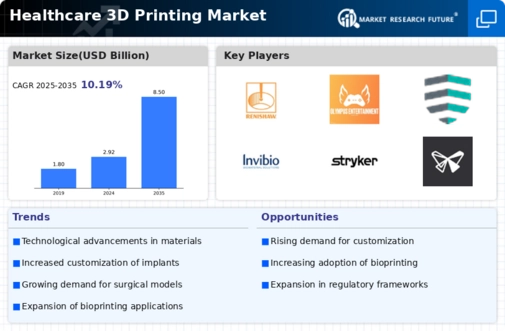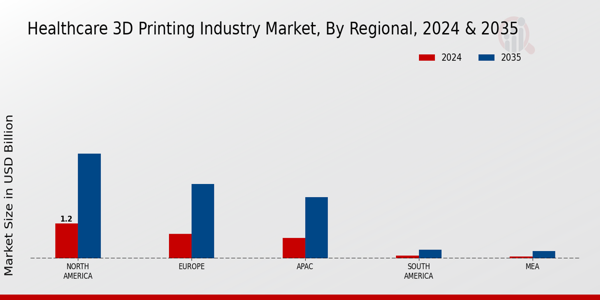Market Growth Projections
The Global Healthcare 3D Printing Market Industry is poised for substantial growth, with projections indicating a market value of 8.5 USD Billion by 2035. This anticipated growth is underpinned by a compound annual growth rate (CAGR) of 10.2% from 2025 to 2035. The increasing adoption of 3D printing technologies across various healthcare applications, including prosthetics, implants, and surgical planning, is likely to drive this expansion. As healthcare providers continue to explore the benefits of 3D printing, the market is expected to evolve, presenting new opportunities for innovation and investment.
Technological Advancements
The Global Healthcare 3D Printing Market Industry is experiencing rapid technological advancements, which are enhancing the capabilities of 3D printing in healthcare. Innovations in materials, such as biocompatible polymers and metals, are enabling the production of more complex and functional medical devices. For instance, the development of 3D-printed organs and tissues is progressing, potentially revolutionizing transplant medicine. As of 2024, the market is valued at approximately 2.92 USD Billion, indicating a growing acceptance of these technologies in clinical settings. This trend is expected to continue, with advancements likely to drive further adoption and investment in the sector.
Cost-Effectiveness of 3D Printing
Cost-effectiveness is a pivotal driver in the Global Healthcare 3D Printing Market Industry, as it offers significant savings in production and material costs. Traditional manufacturing methods often involve high expenses and long lead times, whereas 3D printing can reduce these costs by streamlining the production process. For instance, hospitals can produce surgical instruments on-demand, minimizing inventory costs and waste. This economic advantage is likely to attract more healthcare providers to adopt 3D printing technologies, thereby contributing to a projected CAGR of 10.2% from 2025 to 2035. The financial benefits associated with 3D printing are becoming increasingly apparent.
Rising Demand for Personalized Medicine
The Global Healthcare 3D Printing Market Industry is witnessing an increasing demand for personalized medicine, which is significantly influencing market growth. Customization in medical devices and implants allows for tailored solutions that meet individual patient needs. For example, 3D-printed prosthetics can be designed to fit the unique anatomy of patients, improving comfort and functionality. This shift towards personalized healthcare is expected to contribute to the market's expansion, with projections indicating a growth to 8.5 USD Billion by 2035. The ability to produce patient-specific solutions is likely to enhance treatment outcomes and patient satisfaction.
Growing Applications in Surgical Procedures
The Global Healthcare 3D Printing Market Industry is expanding due to the growing applications of 3D printing in surgical procedures. Surgeons are increasingly utilizing 3D-printed models for preoperative planning and training, which enhances surgical precision and outcomes. For example, 3D-printed anatomical models allow surgeons to visualize complex cases before entering the operating room. This trend is likely to continue as more healthcare institutions recognize the benefits of incorporating 3D printing into surgical workflows. The integration of 3D printing in surgery not only improves efficiency but also contributes to better patient outcomes, further driving market growth.
Regulatory Support and Standards Development
Regulatory support and the development of standards are crucial for the Global Healthcare 3D Printing Market Industry, as they provide a framework for safe and effective use of 3D printing technologies in healthcare. Governments and regulatory bodies are increasingly recognizing the potential of 3D printing in medical applications, leading to the establishment of guidelines and standards. This support fosters innovation and encourages investment in the sector. As the market matures, the establishment of clear regulations is likely to enhance trust among healthcare providers and patients, facilitating broader adoption of 3D printing solutions.





















